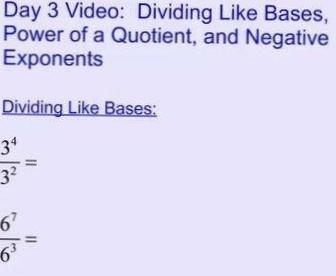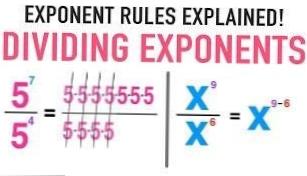Dividing like bases can be a complex concept to grasp, but fear not! Our upcoming article, Dividing Like Bases: A Comprehensive Guide to Effective Strategies, is here to provide you with all the necessary insights and strategies to master this mathematical concept. Whether you’re a student struggling with division or a teacher seeking effective instruction methods, our article will offer step-by-step explanations and valuable tips. Get ready to sharpen your division skills and enhance your understanding of dividing like bases!
Dividing Like Bases: A Comprehensive Guide to Effective Strategies
Introduction to Dividing Like Bases
Welcome to our comprehensive guide on dividing like bases! Whether you’re a math enthusiast or looking to brush up on your skills, this article aims to provide you with a step-by-step breakdown of effective strategies for dividing like bases. From understanding the fundamentals to tackling complex problems, we’ve got you covered. So, let’s dive in and master the art of dividing like bases together!
Dividing like bases involves dividing numbers that have the same base. This concept often appears in various mathematical fields, including algebra and geometry. By understanding the principles and strategies behind dividing like bases, you can gain a solid foundation for solving equations, simplifying expressions, and working with exponents.
Throughout this guide, we will explore different methods to divide like bases, such as using exponent rules, prime factorization, and logarithms. We will walk you through each approach, providing clear explanations and helpful examples along the way.
Now, you might be wondering why dividing like bases is important and how it can be applicable in real-life situations. Well, understanding this concept is crucial in fields like finance, physics, and engineering, where calculations involving exponential values are common.
To make the learning experience more engaging, we will incorporate relevant images and videos throughout the article. These visuals will not only help clarify the concepts but also make the information more accessible and memorable.
In addition to enhancing your understanding, we also aim to optimize this article for search engines. This means that you can easily find this resource when searching for topics related to dividing like bases.
Get ready to embark on an exciting journey of mastering the art of dividing like bases. Whether you’re a student, professional, or simply someone interested in mathematics, this comprehensive guide will equip you with the knowledge and skills you need to excel in dividing like bases. So, let’s get started and unlock the key to effective division strategies!
Common Challenges in Dividing Like Bases: Overcoming Obstacles for Effective Strategies
Dividing like bases can be a daunting task, especially when faced with various challenges that can hinder your progress. In this comprehensive guide, we will explore some of the common obstacles encountered when dividing like bases and provide effective strategies to overcome them. Whether you are a student studying algebra or a professional dealing with complex numerical data, these tips will help you navigate through the difficulties and achieve accurate results.
One of the primary challenges when dividing like bases is dealing with different degrees or powers. When dividing numbers or variables with exponents, it is essential to maintain consistency in the exponents. For example, dividing x^3 by x^2 requires subtracting the exponents: x^(3-2) = x^1 = x.
Another common challenge arises when dividing multiple terms. In such cases, it is crucial to divide each term individually. For instance, dividing (3x^2 + 4x — 5) by 2x requires dividing each term by 2x separately: (3x^2)/(2x) + (4x)/(2x) — (5)/(2x).
Dealing with negative exponents is another hurdle that can arise when dividing like bases. When dividing a number or a variable with a negative exponent, it can be converted to a positive exponent by moving it to the denominator or vice versa. For example, dividing 1/x^(-2) can be rewritten as x^2.
Furthermore, the presence of fractions in the dividend or divisor can often complicate the division process. In such cases, it is helpful to multiply both the dividend and the divisor by the reciprocal of the divisor’s fraction. This step ensures that the division operation remains unaffected. For example, dividing 2/3 by 4/5 can be simplified by multiplying 2/3 by 5/4: (2/3) * (5/4).
In conclusion, although dividing like bases can present challenges, with the right strategies, these obstacles can be overcome. By understanding the rules of exponents, dividing multiple terms individually, converting negative exponents, and dealing with fractions effectively, you can approach any division problem with confidence. Remember, practice and familiarity with these strategies will greatly enhance your mathematical abilities and problem-solving skills.
Effective Strategies for Dividing Like Bases: Maximizing Productivity and Efficiency
Division is a fundamental mathematical operation that we encounter in various aspects of our lives. Whether you are solving complex equations or simply dividing a pizza among friends, having a clear understanding of effective strategies for dividing like bases can save you time and hassle. In this comprehensive guide, we will explore a range of strategies that will not only help you divide like bases but also enhance your overall mathematical skills. So, let’s dive in and discover the secrets to becoming a division maestro!
Real-Life Applications of Dividing Like Bases
Division is one of the fundamental mathematical operations that we encounter in our daily lives, whether we realize it or not. Understanding and effectively using dividing like bases can greatly enhance our problem-solving abilities, and it has numerous real-life applications. One of the most common instances where dividing like bases is essential is when dealing with finances. Whether it’s splitting the bill among friends, calculating taxes, or dividing up a budget, knowing how to divide like bases can help us make fair and accurate calculations. Dividing like bases is also crucial in science and engineering fields. For example, chemical calculations involving the molar mass of compounds rely on dividing like bases to determine the correct ratios. Similarly, engineers need to divide like bases when calculating load distributions or determining the proper dosage of a medicine based on body weight. Furthermore, dividing like bases is relevant in baking and cooking, where precise measurements and portioning are often required. From recipes to construction plans, dividing like bases plays a crucial role in various aspects of our everyday lives.
dividing like bases








